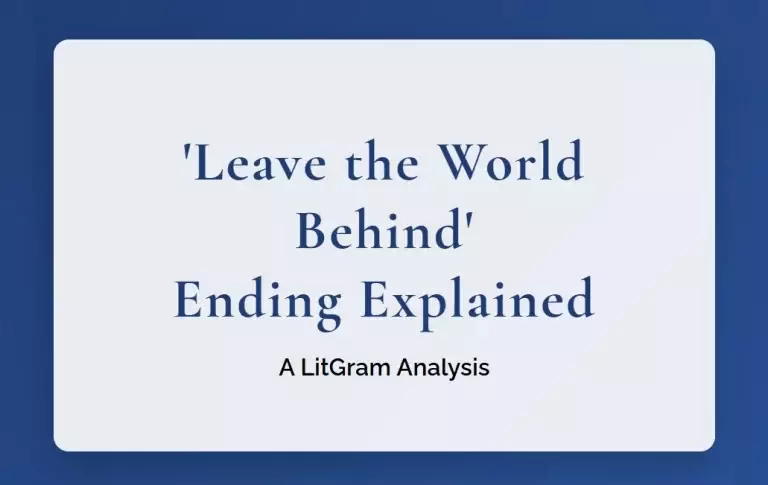In Rumaan Alam’s prescient novel “Leave the World Behind,” the conclusion deliberately resists conventional narrative closure, instead crafting a masterful meditation on uncertainty and collective vulnerability. The novel’s ending, characterized by its strategic ambiguity and haunting resonance, serves as a profound commentary on contemporary anxieties about societal collapse and human interconnectedness.
Leave the World Behind Novel Ending Explained
The Significance of Structural Dissolution
Rumaan Alam in the novel’s concluding chapters mirror its thematic preoccupation with dissolution through increasingly fragmented narrative perspectives. As the mysterious catastrophe unfolds, Alam systematically dismantles the characters’ understanding of their world, leaving them—and by extension, the reader—in a state of perpetual uncertainty. The fractured narrative structure becomes particularly pronounced in the final scenes, where Rumaan Alam employs multiple viewpoint shifts to create a kaleidoscopic vision of impending doom.
The Symbolic Weight of the Finale in
In Rumaan Alam’s novel’s closing moments, the characters find themselves scattered across different locations within and around the vacation house, each experiencing their own version of the apocalypse. This physical separation serves as a powerful metaphor for the atomization of modern society. Rose’s retreat to the basement, Danny’s inexplicable dental agony, and Clay’s final drive represent distinct responses to catastrophe that collectively illuminate the varied ways humans process impending disaster.
The Basement as Metaphorical Underground
Rose’s descent into the basement carries particular symbolic weight. Her discovery of the emergency supplies left by G.H. Washington becomes a moment of dark irony—preparation meets futility in the face of an incomprehensible threat. The basement itself functions as a liminal space between civilization and primitive survival, embodying the thin veneer separating ordered society from chaos.
The Question of Knowledge and Power
Alam’s strategic withholding of information about the precise nature of the catastrophe serves a dual purpose. First, it mirrors the characters’ own limited understanding of their situation, creating a powerful empathetic connection between reader and subject. Second, it suggests that in our hyperconnected age, the loss of information might be more terrifying than any specific disaster.
Race and Class in Crisis
The ending’s power partially derives from how it dismantles the characters’ preconceptions about race and class. The wealthy white family (Amanda, Clay, and their children) and their wealthy Black visitors (G.H. and Ruth) find their social positions rendered increasingly meaningless as society crumbles. The Rumaan Alam’s decision to leave these relationships unresolved speaks to the persistent nature of social divisions even in the face of collective catastrophe.
Technological Failure as Modern Horror
The systematic failure of technology—from cell phones to television to the internet—serves as a crucial element in Rumaan Alam’s conclusion. These failures represent more than mere plot devices; they symbolize the fragility of our interconnected world and our desperate dependence on systems we barely understand.
The Final Scene’s Ambiguous Hope
Rumaan Alam’s novel’s final moments, focusing on Ruth’s observation of the deer, present a complex image of natural continuity amidst human chaos. This conclusion suggests that while human civilization might be on the brink, the natural world persists—though perhaps not in a form we would find comforting. The deer’s presence serves as both a reminder of endurance and a harbinger of a world moving beyond human dominance.
Literary Significance and Contemporary Resonance
Alam’s ending achieves its power through its steadfast refusal to provide closure. Instead, it offers a meditation on the limits of preparation, the futility of privilege, and the fundamental interconnectedness of human experience. The conclusion’s ambiguity serves not as a narrative weakness but as its central strength, forcing readers to confront their own assumptions about security, society, and survival.
In crafting such an open-ended conclusion, Alam has created a powerful commentary on contemporary American life, where the threat of societal collapse looms as a constant possibility, yet remains maddeningly difficult to prepare for or prevent. The ending’s power lies not in what it reveals, but in how it forces us to examine our own vulnerabilities and interconnections in an increasingly precarious world.
Rumaan Alam’s novel’s conclusion thus serves as both warning and meditation—a stark reminder of our collective fragility and an invitation to consider how we might face an uncertain future with greater awareness and humanity. In leaving so many questions unanswered, Alam creates a space for readers to confront their own anxieties about societal collapse while suggesting that perhaps the only meaningful response to uncertainty is human connection, however imperfect it may be.


